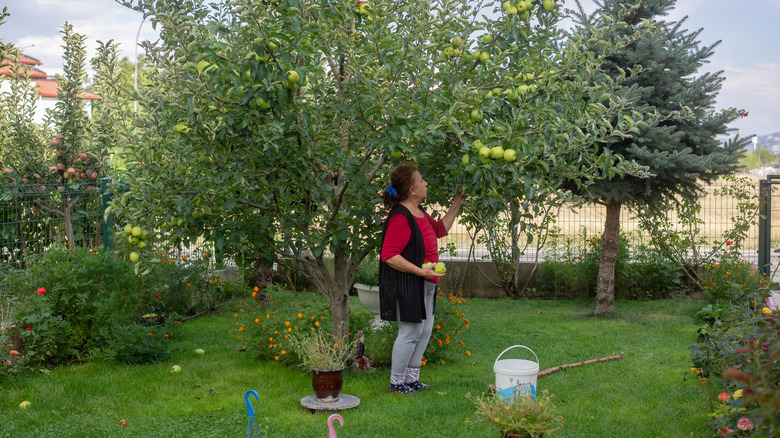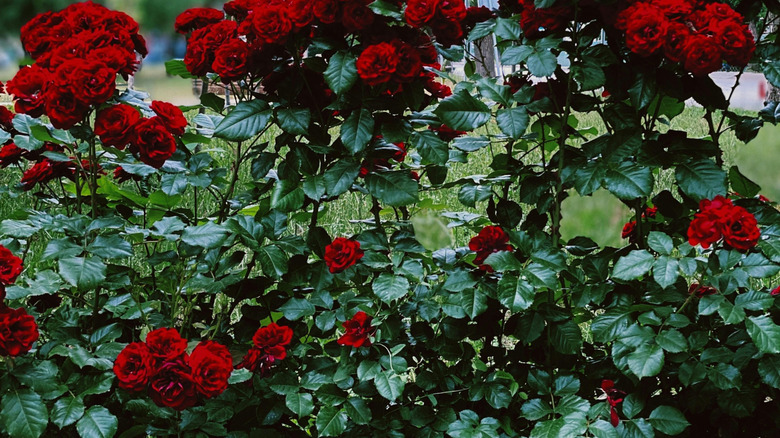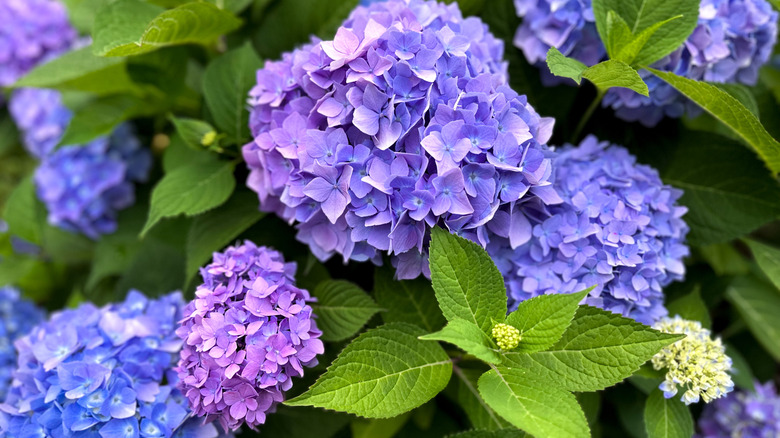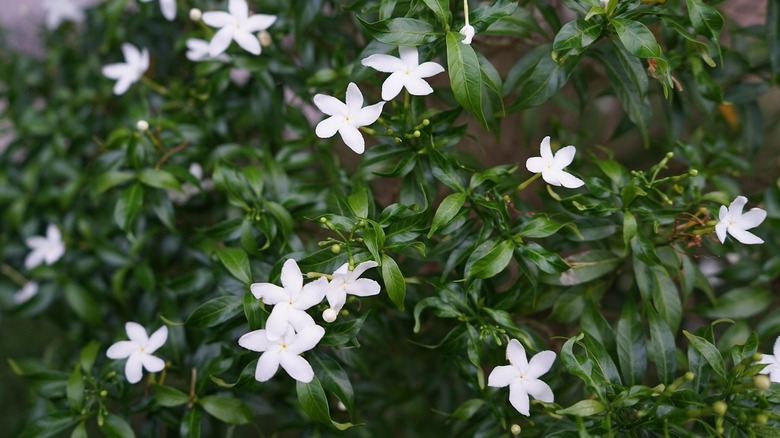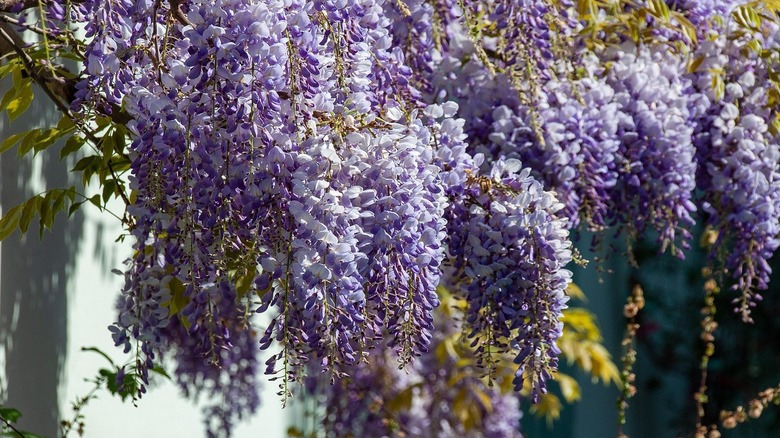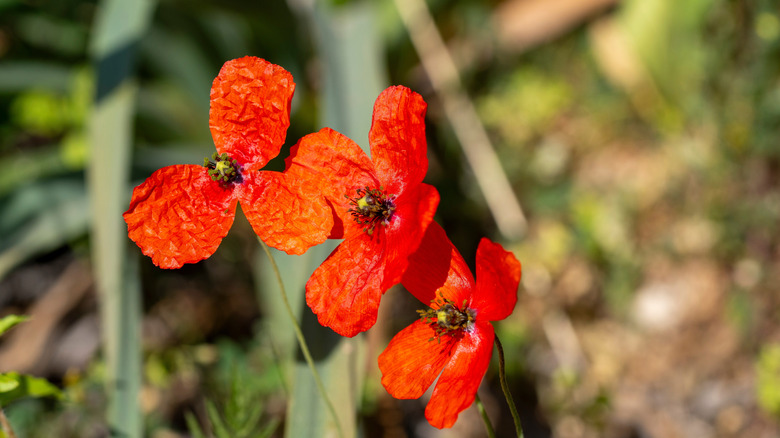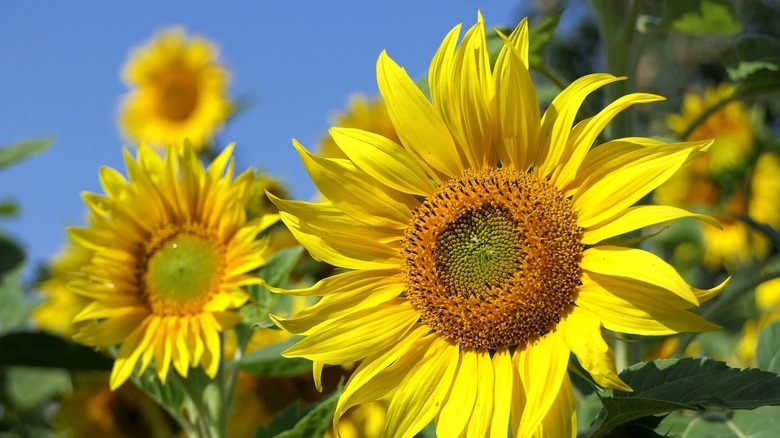Types Of Flowers You Shouldn't Grow Near Fruit Trees
We may receive a commission on purchases made from links.
Planting a flower garden already takes a certain degree of knowledge and tact. However, it becomes a lot more complicated when fruit trees are involved. Fruit trees take strategy to grow, needing plenty of nutrition and care to ensure they put out bountiful harvests year after year. If they aren't planted alongside compatible flowers, both plants may fail to bloom and flourish long-term.
Below are 10 flowers to avoid planting under fruit trees. They aren't compatible due to numerous factors that are detrimental to the trees, flowers, or both. They may need to compete for sustenance, the tree may block too much sunlight with its canopy, or the flowers may attract pests that are damaging to fruit harvests. In other circumstances, the flowers and trees may simply have different growing requirements that make it difficult for them to grow healthily side-by-side. Read on to learn about what flowers you should avoid growing alongside fruit trees and alternative ways to successfully arrange a landscape.
Roses attract aphids and whiteflies with their fragrant blooms
There are many stunning varieties of roses for gardens, but as beautiful as they may be, they aren't a good companion for fruit trees. The strong fragrances of some varieties of roses attract aphids, beetles, mites, and thrips, which are all dangerous for fruit trees. Whiteflies are also drawn to ornamental flowers like rose bushes. They aren't normally a problem for fruit trees but quickly infest avocado, citrus, and pomegranate trees in warmer areas, especially if drawn there by said ornamental plants.
Roses are also impractical for taller fruit trees with large canopies, like mango trees, because the taller plants inhibit the roses' growth. Most rose cultivars need to be in a sunny area where they receive bright light for at least six to eight hours per day. Trees provide too much shade for many rose bushes to grow healthy and produce vibrant flower blooms.
Instead of planting roses below and near fruit trees, put them in a somewhat isolated space away from buildings and other plants. There should also be a three-foot distance from roses on all sides, giving them plenty of room to grow and thrive. On the perimeter of the roses' space, you should plant fragrant herbs, like lavender, rosemary, and sage, which attract pollinators and "good" insects without competing with the roses for resources. Aside from their sunlight requirements, roses generally prefer slightly acidic loamy soil, high nitrogen fertilizers such as Epsoma Organic Rose Tone, and have potential in growing zones 4 through 11, depending on the cultivar.
Hydrangeas compete with trees for water and nutrients
The best spot in your garden for hydrangea flowers isn't beneath a growing fruit tree, as they do not thrive when they have to compete for resources. Growing and established trees prefer large amounts of water, and their roots may overpower freshly planted hydrangea, discouraging them from growing and surviving, particularly during dry spells. Most hydrangeas also prefer the morning sun with partial shade in the afternoon, which is harder to control when growing in the canopy of a larger, mature fruit tree.
Instead of planting hydrangeas near fruit trees, place them in clay, loam, or sand-like soil alongside dogwood, geraniums, hostas, and sedums. They aren't picky about the soil pH but prefer balanced fertilizers, potentially with a higher phosphorus level to promote larger blooms. Such an example is Triple Super Phosphate 0-46-0 Fertilizer. They're growable throughout much of the United States, typically in zones 3 through 9.
Japanese honeysuckle vines have dense growth that can overpower trees
Japanese honeysuckle (Lonicera japonica) is known for its overzealous growth habits — it's a climbing vine invasive to much of the United States. In grassland regions of the northern U.S. where it is not considered invasive, gardeners covet this species for its unique tubular flowers. But, it grows rapidly and densely, tangling itself around other plants and trees, potentially blocking sunlight and growth. Studies have also revealed that Japanese honeysuckle is allelopathic and releases chemicals that slow nearby plant growth. Plants within Japanese honeysuckles' vicinity reportedly have lower leaf nitrogen and diminished photosynthesis, which in the case of fruit trees, naturally slows growth and reduces harvests.
Due to its dangerous nature, avoid planting the Japanese honeysuckle, especially in the eastern United States, where it is especially invasive. It's outright banned in Connecticut, Illinois, Massachusetts, New Hampshire, and Vermont. If you're looking for a stunning, tubular flower that will do well when paired with a fruit tree, try Abelia (Abelia spp.), a shade-tolerant plant native to Mexico and east Asia that is not considered invasive in the United States.
Gardenias don't thrive when fruit trees begin to ripen
There's no question you'll regret planting beautiful gardenia flowers near your fruit trees. When the fruits on trees ripen and rot, they give off ethanol. The ethanol can then react with the gardenias in a negative way, causing their flower petals to fall off. Gardenias typically bloom from May through June, around the same time that apricot, cherry, nectarine, peach, and plum trees produce fruit. On another note, gardenias are known to attract pests that are detrimental to fruit trees. They attract aphids and whiteflies especially, which cause poor-quality fruit and result in sooty mold and other problems. Whiteflies can be especially problematic in avocado and citrus trees.
There's no reason to plant gardenias close to fruit trees when they're excellent companions to many other plants. They thrive next to azaleas, camellias, hostas, and different fern varieties in neutral to acidic loamy soil below a 6 pH level. Zones 8 through 11 have the easiest time growing them, yet certain varieties also prosper in zones 6 and 7.
Wisteria vines climb up trees and smother them
Avoid planting any kind of wisteria near your fruit trees. Some varieties are highly invasive, like Chinese and Japanese wisteria (Wisteria sinensis and Wisteria floribunda, respectively). These wisteria cultivars produce beautiful lilac flower clusters that hang in a formation known as "racemes" but can be deadly to native neighboring foliage. Even the native species of wisteria, Wisteria frutescens, will crawl up trees, stealing nutrients and blocking sunlight. Because fruit trees need all of these resources even more than other trees in order to produce fruit, these vines are especially bad for your harvest.
You should avoid planting all types of wisteria near fruit trees, but avoid Chinese and Japanese wisteria altogether. Instead of growing these invasive plants in your garden, consider a similarly purple flowering herb like lavender. Lavender stalks grow in gorgeous plumes of color and can survive in the canopy of a fruit tree.
Poppies need full sun and attract thrips and aphids
One of the best tips for growing happy and healthy garden poppy flowers is to keep them in full sun. This is impossible in the shade of an especially dense fruit tree, like a large, mature apple tree. This would block them from direct light throughout the day. Poppies (Papaver) also have different soil nutrition needs from fruit trees. They don't need much fertilizer or water before they start flowering. In comparison, fruit trees are on the other end of the spectrum and need the most water in the growing stage before they start fruiting.
Instead of attempting to grow full-sun poppies in the shade of your fruit trees with excessive watering routines, plant them in flower gardens with more compatible plants. They thrive best alongside other springtime plants like lavender and baby's breath. These colorful flowers do best in slightly alkaline and neutral soils with high-phosphorus fertilizer in many USDA growing zones. Different cultivars can thrive in zones 2 through 10.
Creeping Phlox's growing requirements and growth habits aren't compatible with fruit trees
Creeping phlox is a flowering groundcover you don't want crawling over the base of fruit trees. Once established, it only needs supplemental watering, not the substantial watering routine often engaged for healthy and heavy fruit harvests. They prefer full sun, which isn't always available when growing under the sweeping branches of a fully grown fruit tree. Creeping phlox also requires high-phosphorus fertilizer for vibrant flowers, such as Triple Super Phosphate 0-46-0 Fertilizer, which isn't the recommendation for most fruit trees. In the blooming and fruiting season, phlox is likely to out-compete your fruit tree for resources, so they don't make the best of friends.
Save the areas under fruit trees for more compatible plants, and place the creeping phlox on the edges and borders of landscaping instead. They need good sunlight exposure in acidic to neutral soil, from clay-like to loam to rocky. Keep in mind that creeping phlox tolerates a range of soils but is picky when it comes to climate conditions. The gardeners with the most success with these plants live within zones 5 through 8.
Sunflowers need full sun and attract dangerous pests
Beautiful wild sunflowers are considered weeds because they grow densely above and below the soil, spreading quickly across sunlit fields and landscapes. Sunflowers (Helianthus) thrive in full sun, making them a poor choice for planting beneath any tree branches. But, some cultivars are exceptionally large, around 15 feet tall, making them unrealistic for most standard fruit trees, never mind dwarf and semi-dwarf cultivars.
Another downfall is that sunflowers attract pests that can harm fruit trees, such as borers. The sunflower blooms during mid to late summer, helping draw these insects to late-blooming fruit trees, like pears, cherries, plums, and certain apple cultivars.
Instead of growing sunflowers under your fruit tree, you can get your fill of sunshiney yellow blooms by planting a few daffodil bulbs under your tree. They will bloom in early spring, avoiding the fruiting season during which most trees need plentiful resources.
Achira flowers are too large and hungry for nutrients to be planted directly beside a fruit tree
Another flower and root crop combination plant is the Achira (Canna indica), better known as the African arrowroot. These root crops struggle alongside fruit trees for the same reasons Springbank clovers aren't the best fit. You want to avoid growing root crops too close to fruit trees because they're too competitive for resources. Established trees take too many nutrients away from freshly planted root crops. In warm climates, Achiras can grow as tall as 8 feet at full maturity, making them too large to grow close to a fruit tree, especially dwarf or semi-dwarf varieties.
Achiras grow to the size of small trees, meaning they can only be planted alongside garden species that don't mind growing in their shadow. Pick vegetables tolerant of dappled sun and partial shade, such as kale, lettuce, or spinach. In addition to these compatible companion plants, ensure your achiras are grown in a warmer USDA zone, typically zone 8 or higher. They do well in full sun, as they often tower above surrounding plants, and do well in various soil types with a well-balanced fertilizer, such as Jobe's Organics All Purpose Fertilizer.
